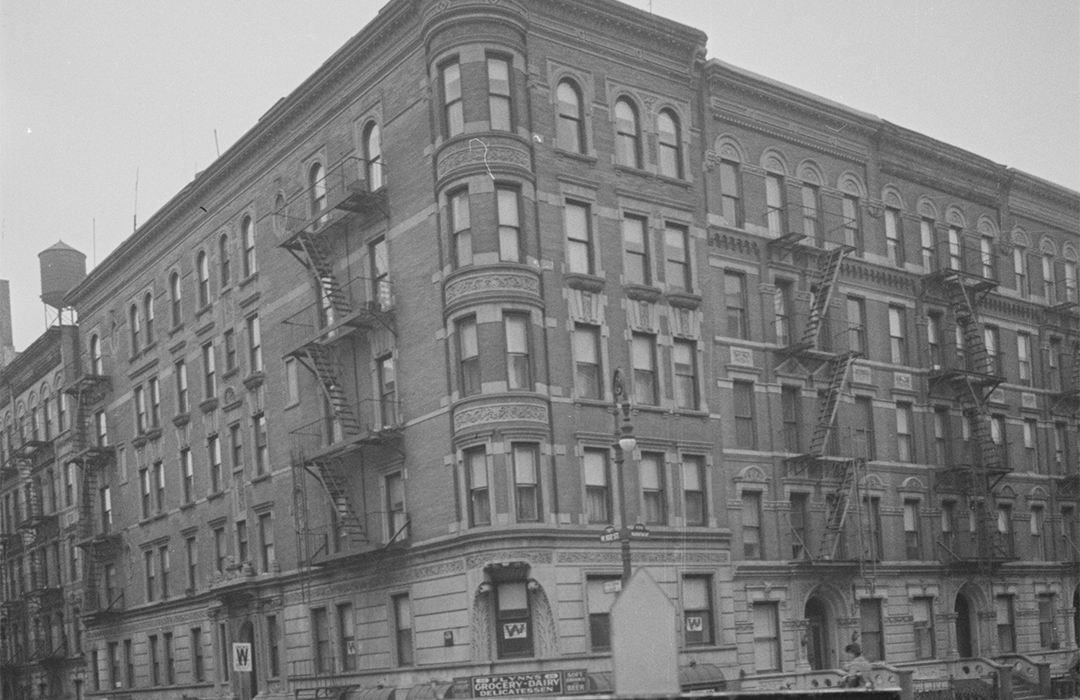
48 Manhattan Ave.
by Tom Miller
In 1895, architect Charles Stegmayer designed six five-story, brick-faced apartment buildings for Jacob Jung that would engulf the eastern Manhattan Avenue blockfront of 101st to 102nd Streets. Inexplicitly, he designed the northernmost building slightly differently than the other, matching structures. The arched entrance at 18 West 102nd Street sat within a rusticated limestone base above a stone stoop guarded by carved, crouching lions. Four pilasters, two decorated with Renaissance carvings, flanked the doorway. The first-floor window above the corner store space in the basement was lavished with gigantic, curling fronds and furling ribbons. Stegmayer rounded the corner, turret-like, of the upper four floors, which were faced in beige brick and trimmed in limestone. A relatively understated bracketed cornice completed the design.
The building opened in 1896. Among the initial tenants was Mrs. Nellie Bartley who suffered a bizarre incident on August 12, 1897. She was waiting for a streetcar at the corner of 102nd Street and Columbus Avenue when she became faint. She asked a butcher’s boy to fetch a glass of water for her. The New York Sun reported, “The boy took her into the rear room of a saloon. After she had drunk a glass of water, Mrs. Bartley became hysterical.”
Dr. J. Clark was called. He gave Mrs. Bartley a sedative and told the barkeeper to notify the police of her condition. By the time Policeman McGroin arrived, she was unconscious. The New York Sun reported, “He made up his mind that she had taken poison.” His decision initiated the first domino to fall in what would become an insufferable string of events. Nellie Bartley was taken to the Manhattan Hospital. When the doctors there could find no trace of poison, they “shipped her over to the Harlem Hospital,” said the newspaper. Policeman McGroin accompanied her, watching her closely. Physicians at that hospital could find no poison, either, so they put Mrs. Bartley on a Charities Department steamboat and sent her to Bellevue Hospital. The Sun said, “McGroin, who felt sure that she had attempted suicide, kept close to her, so that she should have no opportunity to leap overboard.” At Bellevue, doctors once again could find no sign of poisoning, saying that she “was guilty of no crime more serious than that of being taken ill in the street.” After recovering and having been “taken to nearly all the institutions she could be except a police court,” she was allowed to return home.
“I have a little baby. I want you to keep her for a while.”
On the warm evening of August 17, 1903, stockbroker Lawrence E. Darden and his wife took a drive in Central Park in their runabout, a light, open carriage. Darden was driving slowly past the Daniel Webster statue when, according to the New York Herald, “a big racing automobile passed him.” The car panicked Darden’s horse, which bolted, throwing both of its passengers to the pavement. Darden suffered a severe scalp wound, and Mrs. Darden went into shock. They were treated on the site by a doctor from the Park Emergency Hospital. In the meantime, the horse, which had gotten free of the wrecked buggy, was captured by a park policeman. The Dardens returned from what they had anticipated to be a relaxing evening drive in a cab.
All the occupants of 48 Manhattan Avenue maintained domestic help, at least a maid. A broker and his family who lived on the third floor employed Lucy Cortright, described by The Sun as, “his wife’s negro maid of all work.” (A servant of “all work” managed everything from housework to laundry and cooking.) Lucy had worked with the family since 1901. The broker and his wife had two children, Elizabeth and Lawrence.
On a Friday night in July 1904, the broker took Lucy into the kitchen and asked, “Lucy, can you keep your mouth shut?” She said she could, and he handed her $15, saying, “I have a little baby. I want you to keep her for a while.” He told her to meet her at Penn Station in Jersey City the following Monday. She arrived at the station and her employer handed over a crying baby and a bottle of milk. He told her, “Take it quick. I had no sleep all night.”
On July 29, the family disappeared from the building. The wife told Lucy they would send their address as soon as they got settled, but no word was received. On August 21, 1904, the six-week-old baby girl died in Lucy’s apartment on West 126th Street. Lucy had called the doctor the previous day, and he determined the death to be from natural causes.
The Sun said, “Had it not been for that unfortunate circumstance, the infant’s body might have been quietly buried and the police would not have thought it proper to learn why a seemingly prosperous white man formerly living at 18 West 102d street knew about the giving over of a blue eyed, light haired baby girl to the care of Lucy Cortright.” The police could not find a business address for the broker, so they dropped the case and the broker’s name was never released.
Harry L. Finnel lived here in 1908. The Oakland, California, Alameda Daily Argus described him as “a successful inventor, and large returns from his inventions were expected.” But it seems that Finnel’s love life was less successful than his inventions. On August 19, he committed suicide in his apartment by inhaling illuminating gas. He left a note to his brother, H. T. Finnel, that read:
My Dear Brother—this is more than I can stand, so I take this means to end my pain. I trust you and those who are dear to me to forgive me this act. You [can] correspond with Lillian Cunningham, 216 East Eighty-ninth street, and she will tell you all about my last struggle. I will say good-bye through you to mamma and Brothers Weldon and Paul.
Hazel Tobey and her mother moved to New York City in 1910 and into the building. Hazel was known on the vaudeville stage as Hazel Richmond. Shortly after moving to New York, Gordon Pourch saw her in a sketch called “The Editor.” He told her that he was a wealthy widower and asked if he could call. Pourch eventually brought his two children, Grace and Edna, to the Manhattan Avenue apartment and told them to call Mrs. Toby “grandma.”
On January 1, 1913, Pourch proposed. The wedding day was set for Easter Day. Knowing that Pourch would be her husband shortly, Hazel consented to have intimate relations. Then, in February, she received the news that he was dying in a hospital. No further word came. The wedding date came and went, and Hazel “became a sleuth,” as worded by The Brooklyn Daily Times. She went through all the Pourch listings in the Brooklyn directory until she found the right one. Gordon Pourch’s deceased wife, she discovered, was not dead at all, and she had been cruelly duped. On May 8, 1913, The Brooklyn Daily Times reported that Hazel had sued “for disappointment and general injuries to the affections and career she values at $10,000.” The figure would translate to about $327,000 in 2025.
Resident James Rozetto lived here in 1915 and listed his profession as a waiter. But he was making extra money on the side by forced prostitution operating from his apartment. Detectives were alerted there by a masseur advertisement. When the officers showed up on March 25 and showed their badges, 20-year-old Frances L. C. Wragg, a nurse, “fell on her knees and cried: ‘Oh, thank God, you are policemen. You have saved my life.” The Amherst Bee said Frances’s face and body “bore evidence that she had been beaten.” The Brooklyn Citizen added, “She told the police the man constantly threatened to kill her and frequently beat her.” The 27-year-old Rozetto was arrested “as a white slaver.”
“He’s got my bag, he’s got my bag.”
Welterweight fighter John Smith used his good looks, physique, and fame to attract women and swindle them. On October 22, 1918, The Evening World said he cut “a wide swatch for six months in Broadway theatrical and motion picture circles, leaving behind him a trail of bogus checks and several badly bent if not broken hearts.” Police said at least half a dozen women “fell for Smith’s lovemaking, even to the extent of becoming engaged to him, although he has a wife and four stepchildren.” One of those broken hearts belonged to Susan Berol, who lived here. She told police, “He failed to account for a pearl necklace, a watch and a bracelet which he obtained through pawn tickets she gave to him.”
Thirty-one-year-old Grace Cheng arrived in New York from Hong Kong in 1981. In 1986, she moved into an apartment here with her mother and cousin. The building’s superintendent, Ricardo Garay, told The New York Times that she was a waitress. “She would leave the apartment at 9:30 A.M. every day and wouldn’t come back until midnight or 12:30 A. M.”
On the morning of January 8, 1991, Grace was riding the southbound C train as it pulled into the 96th Street station at Central Park West. As she got out, Brian Lawrence grabbed her purse and jumped into the car. Grace held tight to the straps as the doors shut, shouting, “He’s got my bag, he’s got my bag.” As the train moved out of the station, it dragged Grace along the platform. The New York Times reported, “Ms. Cheng slipped into the gap between the car and the platform, nearly severing her left leg and breaking her pelvis, left thigh and left arm.” She died in the hospital at 10:15. The purse snatcher, Brian Lawrence, was arrested shortly afterward. He was charged with murder. In Grace Cheng’s bag was a single $1 bill.
Two days later, Paul Cheng, Grace’s brother, visited the platform with his mother, although she did not want to go. He asked to see the spot where Grace had died, and he left a bundle of flowers. “We are Buddhists,” he explained to the detectives who accompanied them. “We believe that her spirit is alive and will have another life.”
At some point in the second part of the 20th century, the doorway on 102nd Street was blocked up, and the entrance was moved to the former store space on the corner. Around the same time, the cornice was removed, leaving a noticeable scar. Otherwise, Charles Stegmayer’s handsome Renaissance Revival design survives relatively intact.
Tom Miller is a social historian and blogger at daytoninmanhattan.blogspot.com


